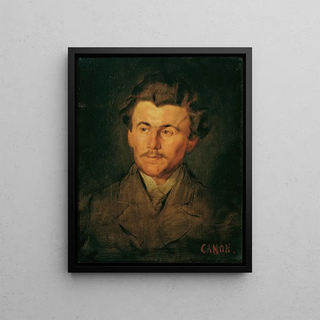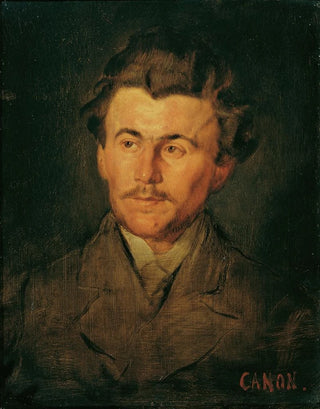Art print | Head study of a man - Hans Canon


View from behind

Frame (optional)
In the vast panorama of art history, some works stand out for their ability to capture the very essence of humanity. The "L Head Study" by Hans Canon is one of those creations that, through its psychological depth and striking realism, invites the viewer to an introspective reflection. This piece, created in the 19th century, transcends the simple exercise of representation to become a true exploration of the human soul. Contemplating this head study, one is immediately struck by the finesse of the features and the intense expression that seems to emanate from the face. Canon succeeds in bringing the stone to life, making it vibrate with emotion, making this work a must-have for art enthusiasts.
Style and uniqueness of the work
Hans Canon's style is characterized by meticulous attention to detail and exceptional mastery of sculpture techniques. In the "L Head Study," every line, every shadow, is carefully crafted to create an illusion of depth and life. The texture of the surface, although rigid, seems almost to breathe, as if the depicted character were about to come to life. Canon manages to balance realism with a certain idealization, offering a vision that is both faithful and poetic of his subject. This work perfectly illustrates the ability of art to transcend time and establish a dialogue between the past and the present. Light plays a crucial role in this piece, accentuating contours and revealing nuances of emotion, allowing the viewer to feel an intimate connection with the subject.
The artist and his influence
Hans Canon, an Austrian-born sculptor and painter, left an indelible mark on the art world through his innovative approach and commitment to realism. Trained in the workshops of the great masters of his time, Canon developed a style that combines tradition and modernity. His influence is felt not only in his works but also through his students and contemporaries. By addressing universal themes such as the human condition, he managed to reach a broad audience, making his art accessible while maintaining intellectual depth. The "L Head Study" is emblematic of this approach, demonstrating Canon's ability

Matte finish

View from behind

Frame (optional)
In the vast panorama of art history, some works stand out for their ability to capture the very essence of humanity. The "L Head Study" by Hans Canon is one of those creations that, through its psychological depth and striking realism, invites the viewer to an introspective reflection. This piece, created in the 19th century, transcends the simple exercise of representation to become a true exploration of the human soul. Contemplating this head study, one is immediately struck by the finesse of the features and the intense expression that seems to emanate from the face. Canon succeeds in bringing the stone to life, making it vibrate with emotion, making this work a must-have for art enthusiasts.
Style and uniqueness of the work
Hans Canon's style is characterized by meticulous attention to detail and exceptional mastery of sculpture techniques. In the "L Head Study," every line, every shadow, is carefully crafted to create an illusion of depth and life. The texture of the surface, although rigid, seems almost to breathe, as if the depicted character were about to come to life. Canon manages to balance realism with a certain idealization, offering a vision that is both faithful and poetic of his subject. This work perfectly illustrates the ability of art to transcend time and establish a dialogue between the past and the present. Light plays a crucial role in this piece, accentuating contours and revealing nuances of emotion, allowing the viewer to feel an intimate connection with the subject.
The artist and his influence
Hans Canon, an Austrian-born sculptor and painter, left an indelible mark on the art world through his innovative approach and commitment to realism. Trained in the workshops of the great masters of his time, Canon developed a style that combines tradition and modernity. His influence is felt not only in his works but also through his students and contemporaries. By addressing universal themes such as the human condition, he managed to reach a broad audience, making his art accessible while maintaining intellectual depth. The "L Head Study" is emblematic of this approach, demonstrating Canon's ability






